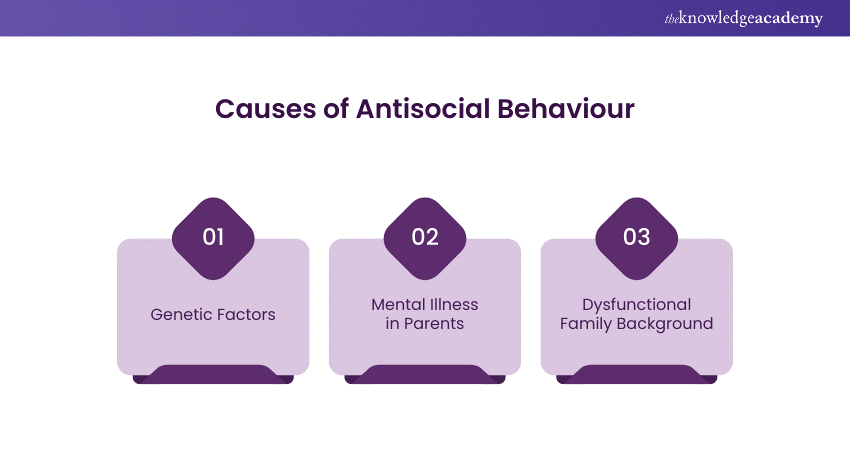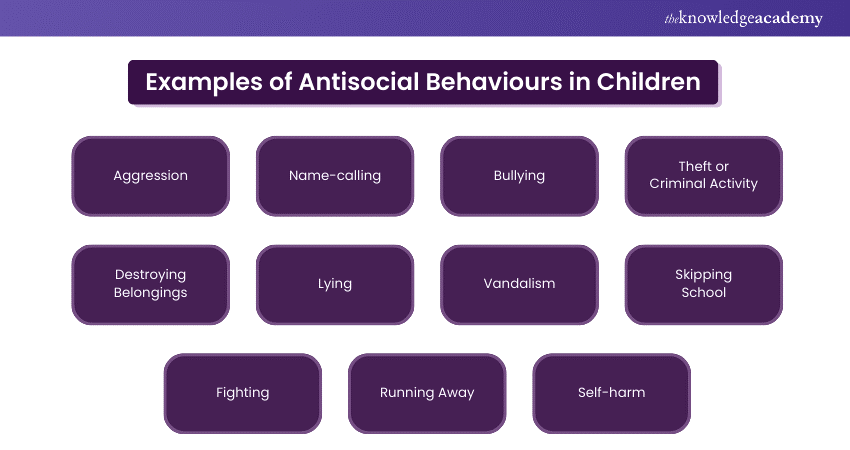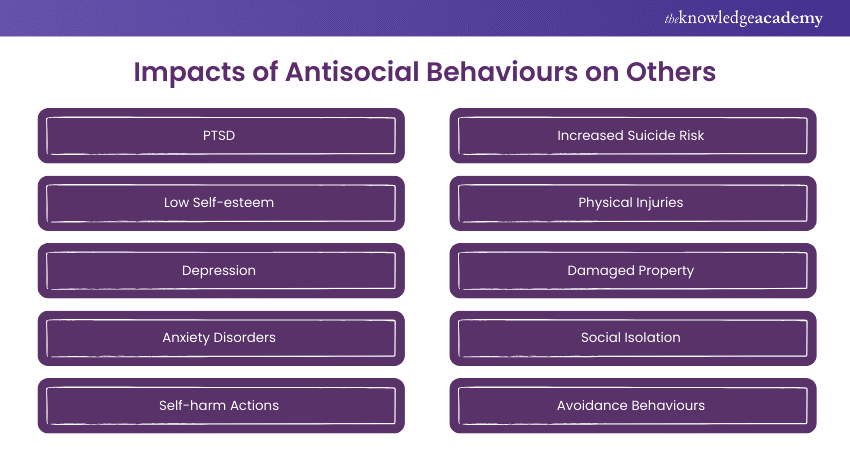We may not have the course you’re looking for. If you enquire or give us a call on +44 1344 203 999 and speak to our training experts, we may still be able to help with your training requirements.
Training Outcomes Within Your Budget!
We ensure quality, budget-alignment, and timely delivery by our expert instructors.

What exactly is Antisocial Behaviour? It includes behaviours that cause harm to others or go against societal norms, going beyond simply being impolite. From acts of vandalism to instances of aggression, these actions frequently breach legal regulations and lead to severe repercussions. Recognising and addressing these issues relies heavily on understanding Antisocial Behaviour.
Understanding Antisocial Behaviour is important whether you are encountering it locally or just want to know more, as it helps create a safer community for all. This blog delves into the causes, examples, and consequences, providing an understanding of its societal influences.
Table of Contents
1) What is Antisocial Behaviour?
2) Types of Antisocial Behaviour
3) Root Causes of Antisocial Behaviour
4) Examples of Antisocial Behaviour
5) Impacts of Antisocial Behaviour
6) Reporting Antisocial Behaviour
7) Conclusion
What is Antisocial Behaviour?
Antisocial Behaviour can be seen from different angles. Legally speaking, it refers to behaviours that violate laws and disturb societal peace, like destruction of property or stealing. Socially, it denotes actions that violate a community's standards and beliefs, resulting in suffering or damage to others.
Mentally, Antisocial Behaviour can be caused by psychological problems like personality disorders, which lead to challenges in feeling empathy and controlling impulses. From a communal point of view, it disturbs tranquillity, resulting in feelings of fear and a decline in overall well-being. Officials frequently perceive it as a problem that necessitates implementing both intervention and prevention tactics.
Every viewpoint underscores the intricate nature of Antisocial Behaviour, stressing the importance of a thorough approach to comprehensively comprehend and combat it successfully.
Types of Antisocial Behaviour
Antisocial Behaviour comes in various forms, affecting individuals, communities, and the environment. Let's understand the different types helps in identifying and addressing these disruptive actions effectively.
1) Nuisance
This involves behaviours such as driving around town aimlessly, loud gatherings, and disruptions from unruly residents in the neighbourhood. It disturbs the peace of the public and impacts the well-being of the community.
2) Environmental
Some examples are littering, putting up posters illegally, and leaving vehicles unattended. These behaviours damage the natural surroundings and deteriorate communal areas.
3) Personal
It includes actions such as bullying, annoying phone calls, and entering someone's property without permission. These activities focus on specific people, leading to feelings of tension and worry.
Learn effective strategies for managing disruptive actions with our Anti Social Behaviour Management Training – Register now!
Root Causes of Antisocial Behaviour
Antisocial behaviour can be influenced by multiple factors, including genetics, home environment, and having a parent with a mental illness. There isn't a single cause behind it.

1) Genetic Factors
Genetic factors, along with the prenatal environment, contribute to the outcome. The chances of Antisocial Behaviours are higher when there is maternal drug use or trauma during pregnancy. Genetics can make individuals more likely to have certain traits because of their influence on the structure of the brain.
2) Mental Illness in Parents
Offspring individuals with Antisocial Behaviours or mental health problems face an increased likelihood of experiencing negative outcomes. Parental substance abuse, unstable home environments, child abuse, and inconsistent parenting all contribute to increasing this risk.
3) Dysfunctional Family Background
Dysfunctional families frequently play a role in the development of Antisocial Behaviours. Coercive tactics or fear are employed in these settings, resulting in inadequate emotional regulation in kids. Children can also acquire these behaviours by observing them at school or witnessing violence in the community.
Examples of Antisocial Behaviour
Antisocial Behaviours are frequent occurrences, and if left unattended, they have the potential to develop into severe mental health problems. In kids, these behaviours frequently involve either being alone or harassing others. Nonetheless, individuals under the age of 18 are unable to receive a diagnosis until they reach adulthood.
Antisocial Behaviour in Adults
Adults engaging in Antisocial Behaviour often exhibit more severe actions compared to children, which could result in legal issues, criminal charges, or incarceration.
Examples of Adult Antisocial Behaviours:
a) Aggression: Aggressive behaviour includes driving aggressively, shouting, or bullying others
b) Abuse: Physical, mental, sexual, or emotional harm inflicted on others
c) Bullying: Harassment of individuals at work or at home is known as bullying
d) Arson: Arson involves intentionally starting fires with the aim of damaging property
e) Substance Abuse: Drug or alcohol dependency leads to deteriorating behaviour
f) Indecent Exposure: Intentionally revealing private parts constitutes indecent exposure
g) Public Behaviour: Operating in a hostile and aggressive manner in public spaces
h) Threats of Violence: Intimidation or threats to cause harm to others
i) Vandalism: Vandalism involves the destruction of property that belongs to the public
j) Criminal Activities: Engaging in illegal behaviour or pushing the limits of the law, such as criminal activities.
k) Trespassing: Deliberately accessing off-limits locations or personal premises
Master the fundamentals of effective people management with our Introduction To Managing People Course – Sign up now!
Antisocial Behaviour in Children
Antisocial Behaviour may begin as young as 4-5 years of age. Although these behaviours might coincide with initial indicators of sociopathy, it is important to closely monitor all behaviours to distinguish between the two.
Examples of Antisocial Behaviours in Children:

a) Aggression: Aggressive behaviour includes pushing, shoving, yelling, or speaking disrespectfully to classmates.
b) Name-calling: Name-calling involves mocking others using disrespectful labels
c) Bullying: Bullying is the act of behaving arrogantly and making fun of other kids
d) Theft or Criminal Activity: Crimes such as stealing, arson, or trespassing
e) Destroying Belongings: Deliberately damaging someone else's belongings
f) Lying: Making up untrue narratives and pointing fingers at others
g) Vandalism: Vandalism is the act of spray-painting walls or damaging public property
h) Skipping School: Skipping school refers to either leaving school without permission or completely not attending.
i) Fighting: Engaging in physical altercations with others
j) Running Away: Departing from home without notifying anyone
k) Self-harm: Self-injury involves actions such as burning, cutting, or pinching oneself
Impacts of Antisocial Behaviour
Antisocial Behaviour impacts all individuals involved. Individuals who display these behaviours frequently face difficulties in keeping connections with others, resulting in feelings of solitude and emptiness, which may then result in more harmful behaviours. Those who are affected may also experience anxiety, PTSD, or depression if the behaviour is not acknowledged and fixed.
Impacts on the Person Having Antisocial Behaviour:
a) Substance Misuse: Growing dependence on drugs or alcohol
b) Depression: Continuing emotions of sorrow and despair
c) Desensitisation to Violence: Decreased sensitivity towards violent actions
d) Incarceration: Higher likelihood of being incarcerated
e) Injuring or Killing Someone: Ability to result in serious injury or fatality
f) Relationship Problems: Challenges in maintaining positive relationships
g) Poor Work or Academic Performance: Decrease in performance at work or in school
h) Premature Death: Increased chance of dying young
Impacts on Others:

a) PTSD: PTSD is a persistent mental condition caused by experiencing Antisocial Behaviour
b) Low Self-esteem: Reduced feeling of one's own value
c) Depression: Emotions of hopelessness and sorrow
d) Anxiety Disorders: Increased feelings of anxiety and fear
e) Self-harm Actions: Participating in self-harm behaviours
f) Increased Suicide Risk: Increased chance of suicidal ideation or behaviours
g) Physical Injuries: Physical injuries refer to experiencing physical damage
h) Damaged Property: When personal belongings are lost or destroyed
i) Social Isolation: Social isolation involves distancing oneself from social contacts
j) Avoidance Behaviours: Staying away from specific individuals or locations
Reporting Antisocial Behaviour
We can only address reports of Antisocial Behaviour that are considered serious, criminal, or pose a risk to individuals. In other situations, it is advisable to get in touch with your local authority, social housing landlord, or the police. They possess the ability to address these problems. Maintain a log of occurrences and conduct; this will aid in inquiries.
a) Social Housing:
If you live in social housing, report any antisocial behaviour to your landlord or housing association. They have protocols in place to address these issues, including mediation and legal actions. Keeping them informed helps maintain a safe and peaceful community.
b) Private Sector:
For private renters or homeowners, contact the specialised team at your local council for support with antisocial behaviour. Councils can provide resources like community mediation and issue formal notices. They work within local regulations to address and resolve the issues effectively.
c) Police:
Contact the police if the antisocial behaviour involves criminal activity or poses a direct threat. The police are equipped to handle urgent situations and can provide immediate assistance. For less severe issues, it’s advisable to first consult your local authority or landlord.
Conclusion
Addressing Antisocial Behaviour is essential for maintaining safe and healthy communities. By understanding its causes and impacts and knowing how to respond, we can prevent these behaviours from escalating. Early intervention, support for those affected, and community efforts are all crucial. Tackling Antisocial Behaviour requires collective action. By being aware and proactive, we can foster environments where respect and positive interactions thrive, thereby reducing the negative effects on individuals and society.
Equip yourself with techniques for managing tough personalities with our Dealing With Difficult People Training today!
Frequently Asked Questions

Antisocial Behaviour causes disturbances within communities, harms relationships, and leads to an increase in crime rates. It can result in individuals becoming isolated and dealing with mental health problems and legal issues while also causing fear and distress.

Encourage early action, foster good behaviour, and ensure availability of mental health services. Participate in community initiatives and promote reporting to authorities to tackle and prevent Antisocial Behaviour, guaranteeing a secure atmosphere for everyone.

Aggression towards others, lack of respect for laws or social norms, and a tendency to be deceitful or manipulative are typical indicators. These actions frequently result in disagreements and have the potential to worsen if not dealt with promptly.

The Knowledge Academy takes global learning to new heights, offering over 30,000 online courses across 490+ locations in 220 countries. This expansive reach ensures accessibility and convenience for learners worldwide.
Alongside our diverse Online Course Catalogue, encompassing 19 major categories, we go the extra mile by providing a plethora of free educational Online Resources like News updates, Blogs, videos, webinars, and interview questions. Tailoring learning experiences further, professionals can maximise value with customisable Course Bundles of TKA.

The Knowledge Academy’s Knowledge Pass, a prepaid voucher, adds another layer of flexibility, allowing course bookings over a 12-month period. Join us on a journey where education knows no bounds.

The Knowledge Academy offers various Management Courses, including the Anti-Social Behaviour Management Training, Introduction To Managing People, and Personal & Organisational Development. These courses cater to different skill levels, providing comprehensive insights into Behaviour Management.
Our Business Skills Blogs cover a range of topics related to Behaviour Management, offering valuable resources, best practices, and industry insights. Whether you are a beginner or looking to advance your Business Skill. The Knowledge Academy's diverse courses and informative blogs have got you covered.
Upcoming Business Skills Resources Batches & Dates
Date
 Anti Social Behaviour Management Training
Anti Social Behaviour Management Training
Fri 10th Jan 2025
Fri 14th Mar 2025
Fri 9th May 2025
Fri 11th Jul 2025
Fri 12th Sep 2025
Fri 14th Nov 2025







 Top Rated Course
Top Rated Course



 If you wish to make any changes to your course, please
If you wish to make any changes to your course, please


